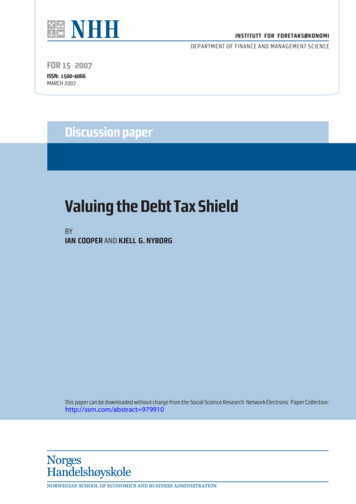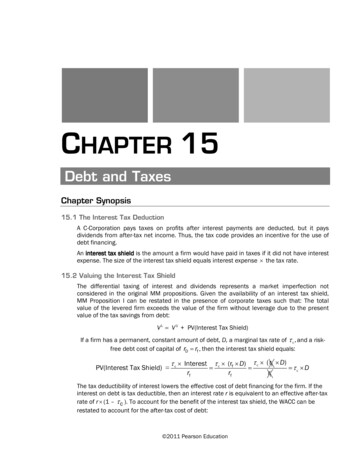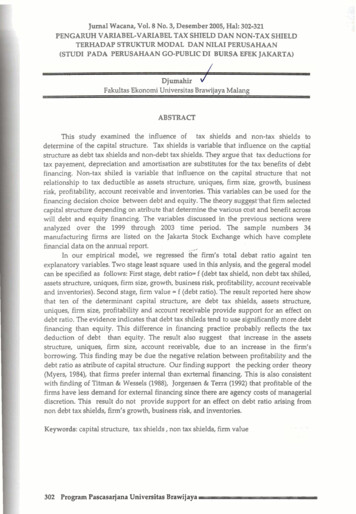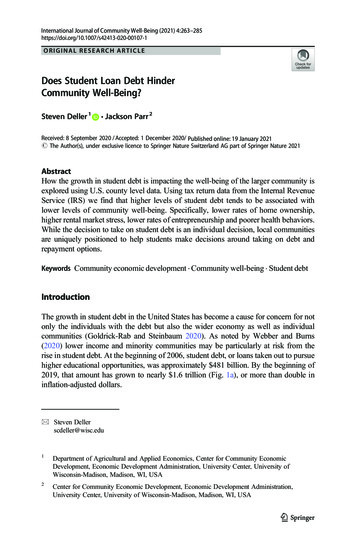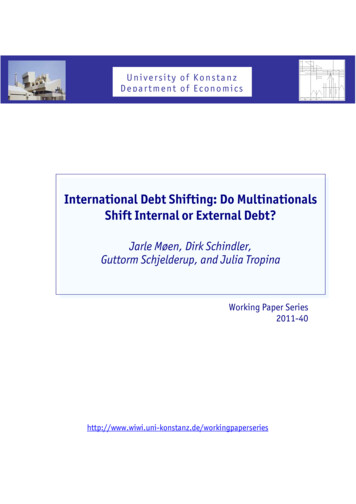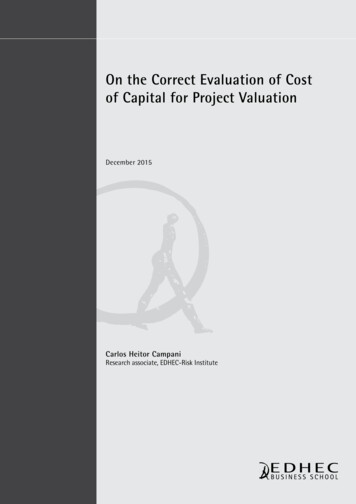
Transcription
Arbeitskreis Quantitative SteuerlehreQuantitative Research in Taxation – Discussion PapersMarcel Fischer / Bjarne Astrup JensenThe Debt Tax Shield,Economic Growth and Inequalityarqus Discussion Paper No. 219May 2017www.arqus.infoISSN 1861-8944
The Debt Tax Shield,Economic Growth and Inequality Marcel Fischer†Bjarne Astrup Jensen‡This version: May 2017Preliminary and incomplete, please do not distribute Weare grateful for helpful comments and suggestions from Raphael Flore, Olaf Korn, John Neumann, Malte Schumacher, Robert Schwager, Laurent Weill and seminar participants at the University of Göttingen, the DGF Conference, Bonn (2016), the Konstanz-Strasbourg Workshop onInvestments, Portfolio Choice and Asset Pricing, the World Finance Conference, New York (2016)and the SGF Conference, Zürich (2017).† Copenhagen Business School, Department of Finance, Solbjerg Plads 3, DK-2000 Frederiksberg,Denmark and University of Konstanz, Department of Economics, Postbox 147, D-78457 Konstanz,Germany, phone: 49 7531 882645, e-mail: marcel.fischer@uni.kn.‡ Copenhagen Business School, Department of Finance, Solbjerg Plads 3, DK-2000 Frederiksberg,Denmark, Bjarne Astrup Jensen, phone: 45 3815 3614, e-mail: ba.fi@cbs.dk.
AbstractThe Debt Tax Shield, Economic Growth and InequalityWe study the implications of the corporate debt tax shield in a growth economy that taxeshousehold income and firm profits and redistributes tax revenues in an attempt to harmonizethe lifetime consumption opportunities of households that differ in their endowments. Ourmodel predicts that the debt tax shield (1) increases the risk-free rate, (2) leads to a highergrowth rate of the economy, and (3) increases the degree of disparity in households’ lifetimeconsumption opportunities. We further show that the debt tax shield affects the tradeoffbetween the goals of achieving a high growth rate of the economy and a low degree ofinequality and quantify this tradeoff.Key Words: debt tax shield, macroeconomic growth, redistributive tax systemJEL Classification Codes: E21, E23, G11, H23, H31, H32
1IntroductionDeparting from the pioneering work of Modigliani and Miller (1958), a huge literature investigates corporate capital structure decisions. Especially the tax-deductibility of corporateinterest expenses – the corporate debt tax shield – has caught a lot of attention in both theoretical and empirical work. This literature demonstrates that the debt tax shield heavilyaffects corporate financial structure decisions. However, the macroeconomic implications ofthe debt tax shield, which our work focuses on, have been largely overlooked so far.We set up a general-equilibrium model with a representative firm, households that differby their initial endowments, and a government that taxes household income as well as firmprofits and redistributes tax revenues in an attempt to reduce disparities in lifetime consumption opportunities among households. Households earn income by investing into riskycorporate equity, risk-free corporate debt, and risk-free bonds traded among the households.Our model makes two main predictions. First, it predicts the debt tax shield to increasethe risk-free rate, reflecting that debt holders want their share of the tax advantage from thedebt tax shield. Second, the higher risk-free rate decreases the price of future over presentconsumption, which leads to higher savings and thus, in the end, to a higher growth rate ofthe economy.On the other hand, a partial effect of the debt tax shield is to lower tax revenues, therebylowering transfers paid out to poorer households which, ultimately, leads to a higher degree ofinequality in households’ lifetime consumption opportunities. In this manner, a high growthrate of the economy and a reduction of the disparities in lifetime consumption opportunitiesamong households trade off against each other. For example, a reduction in the gross growthrate of consumption by 0.7% can increase the consumption share of a poorer household withan initial endowment of 20% of the average initial endowment from 25.2% of the averageconsumption level to 29.8%.An endogenous determination of corporate capital structure is important for a betterunderstanding of the macroeconomic implications of the debt tax shield. In our model, weoperate with a representative firm for which corporate leverage is chosen such that the payoutto shareholders is non-negative in all states of the world. Although any single firm may besubject to default risk, this is reasonably assumed not to be the case for the representativefirm, which is assumed to maximize shareholder value by choosing a maximal degree oflevering subject to this constraint. That is, if the tax burden on firm profits paid out tohouseholds as interest is lower than that paid out as dividend, there is a tax advantage todebt financing, and the firm operates with leverage;Otherwise the firm remains unlevered. Whether such a tax advantage exists depends,1
among other things, on whether the debt tax shield applies. Hence, the decision of the firmon whether to lever up or not is affected by whether a debt tax shield exists or not.Our work contributes to two important lines of literature. It complements the literaturedealing with the macroeconomic implications of taxes. It is a well-known fact that it is generally not optimal to tax accumulating production factors, because this discourages savings,slows down factor accumulation and thus, ultimately, innovation (Mukherjee, Singh, andZaldokas, 2016) and economic growth (e.g., Diamond, 1975; Eaton and Rosen, 1980; Varian, 1980; Judd, 1985; Chamley, 1986; Jones, Manuelli, and Rossi, 1997).1 Simultaneously,Hackbarth, Miao, and Morellec (2006) and Chen (2010), among others, demonstrate thatmacroeconomic conditions affect corporate capital structure decisions. However, the reversechannel, i.e., how the debt tax shield and its effect on corporate capital structure decisionsaffect macroeconomic conditions, such as the risk-free rate, the growth rate of the economy,or the allocation of resources among households, has received surprisingly little attentionso far. Simultaneously, our work extends this line of literature by allowing for non-uniformtaxation of capital income.Our work further contributes to a growing literature on the implications of the debttax shield. The debt tax shield has recently caught renewed interest in both theoretical andempirical work. Empirical work estimates that the debt tax shield accounts for about 10% ofcorporate values (e.g., Graham, 2000; Kemsley and Nissim, 2002; vanBinsbergen, Graham,and Yang, 2010), depicts the evolution of corporate leverage ratios over time (DeAngelo andRoll, 2015; Graham, Leary, and Roberts, 2015) as well as over the business cycle (Korajczykand Levy, 2003; Halling, Yu, and Zechner, 2016), and documents that taxes in general, andthe debt tax shield in particular, significantly affect corporate capital structure decisions(e.g., MacKie-Mason, 1990; Graham, 1996, 1999; Gordon and Lee, 2001; Hovakimian, Opler,and Sheridan, 2001; Bell and Jenkinson, 2002; Graham and Lucker, 2006; Becker, Jacob, andJacob, 2013; Longstaff and Strebulaev, 2014; Devereux, Maffini, and Xing, 2015; Doidge andDyck, 2015; Faccio and Xu, 2015; Heider and Ljungqvist, 2015; Faulkender and Smith, 2016;Ljungqvist, Zhang, and Zuo, 2017). Schepens (2016) argues that this makes tax shields avaluable tool for policy makers. However, all these papers focus on the impact of the debttax shield for corporate valuation and capital structure decisions, but do not investigate thebroader macroeconomic implications of the debt tax shield, which are the focus of our work.Theoretical work, including Miles and Ezzell (1980) and Cooper and Nyborg (2006), hasso far primarily focused on the valuation of the debt tax shield. A notable exemption is the1Boskin (1978), Blanchard and Perotti (2002), Romer and Romer (2010), and Cloyne (2013) provide supporting empirical evidence. Optimal redistribution is studied, among others, in Golosov, Troshkin, andTsyvinski (2016).2
work of Fischer and Jensen (2016) that investigates how the debt tax shield affects households’ consumption-investment strategies via the government’s budget constraint. However,their work builds on an endowment economy model. In their framework, the growth rateof the economy is thus exogenously given, which renders an investigation of the broadermacroeconomic implications impossible. Our work instead builds on a production economyand predicts that the debt tax shield significantly affects macroeconomic variables, such asthe risk-free rate, inequality, and the growth rate of the economy.This paper contributes to a line of research that Fama (2011) calls one of the big openchallenges in financial economics: understanding the implications of corporate taxation.Our work extends the existing literature in several important dimensions. It shows thatthe debt tax shield not only affects corporate leverage, but also has broader macroeconomicimplications. The debt tax shield has an increasing effect on the risk-free rate, which in turndecreases the relative price of future versus present consumption. As a result, savings andinvestments increase, resulting in a higher growth rate of the economy.The debt tax shield also leads to lower tax revenues, thereby to lower transfers from richerto poorer households and thus, ultimately, to a higher degree of inequality in households’lifetime consumption opportunities. That is, the debt tax shield contributes to a highergrowth rate of the economy at the expense of a higher degree of inequality. More generally,the objectives of attaining a high growth rate of the economy and a reduction of the degreeof disparity in households’ lifetime consumption opportunities trade off against each other.Intuitively, the government could try to increase the growth rate of the economy byinvesting into the production process itself. However, households can and will undo anyeffect that such government policy may be intended to have. Hence, there is no scope forsuch fiscal interventions in our model.This paper proceeds as follows. Section 2 outlines our model. In section 3, we presentits analytical solution and discuss our model’s predictions. In section 4, we illustrate thequantitative implications of the debt tax shield for the risk-free rate, economic growth, andinequality. Section 5 concludes. The appendix provides proofs of our theorems.22.1The debt tax shield in a production economyThe economyWe consider an economy populated by n households and a representative firm, that makesup the production sector. The firm has a risky one-period production technology. That is,it only generates an output in the next period. This output can either be consumed or be3
reinvested in preparation for consumption in the subsequent periods. The output producedaand available at time t depends on the evolution of the economy. It is given by Gt It 1, whereaGt is the gross growth factor per unit of investment made at time t 1 and It 1 denotesthe aggregate investment in the production technology. For simplicity, we assume that thegrowth rates are independent and identically distributed copies of a discrete random variableG with M possible realizations Gm , where G1 G2 · · · GM . In the sequel we assumethat these M realizations have equal probabilities 1/M .2Our production technology model is a discrete time version of the classical Cox-IngersollRoss model (Cox, Ingersoll, and Ross, 1985), without intertemporal uncertainty about theproduction technology. The production technology can be thought of as a farmer growinga perishable output, such as corn, with an identical distribution of the outcome from yearto year. The next year’s harvest depends on how much of this year’s harvest is used forreplanting and on the exogenously given realization of the growth rate of the output process,that may, e.g., reflect different weather conditions.2.2Corporate leverageTo run the production technology, the firm issues equity and corporate debt that the households can invest into. The aggregate investment, Ita , made at time t is financed by theaggregate amount of equity invested, Eta , and the aggregate amount of corporate debt, δta ,outstanding from time t to t 1. An endogenous determination of corporate leverage inresponse to tax incentives is a centerpiece in understanding the macroeconomic implicationsof the debt tax shield. We follow one of the standard assumptions in the literature andassume that the firm’s CEO chooses a constant leverage ratio L. Apart from this constrainton the relation between Eta and δta , the supply of aggregate investment opportunities is perfectly elastic. The use of a constant leverage ratio is often referred to as the Miles-Ezzellassumption (Miles and Ezzell, 1980). It is used, among others, in the work of Cooper andNyborg (2006, 2008).If the total tax burden on firm profits paid out to households as interest on corporatedebt is higher than that paid out as dividend to equity holders, i.e., there is a tax advantageof equity financing, the CEO decides to remain unlevered. Otherwise, the CEO chooses themaximum possible degree of leverage that ensures a non-negative return to shareholders in allstates.3 The non-negativity of net returns simultaneously ensures a positive tax basis from2The assumption of equal probabilities is solely made to ease notation. Our results can be generalized toallow for unequal probabilities with similar qualitative conclusions, although with a significantly blown-upamount of notation.3In the proof of Theorem 1, we show that this is tantamount to maximizing the expected gross growth oninvestments into firm equity under the risk-neutral measure.4
taxing corporate profits. Since the total tax burden on firm profits paid out to householdsas interest depends on whether the debt tax shield applies, corporate leverage is affected bywhether the debt tax shield applies.2.3Traded assetsHouseholds can trade three assets. First, households can trade a locally risk-free one-periodbond paying a pre-tax return of rt from time t to t 1. We denote household j’s position inthat asset by βt,j . This asset comes in zero net supply. That is, if some households want tohold a long position in that asset, the market equilibrium has to bring about an interest ratethat makes other households willing to issue such an asset. Second, households can investinto the firm’s equity that entitles them to the firm’s payout in proportion to their share ofequity. We denote household j’s investment into the firm’s equity from time t to t 1 by Et,jEand its share of equity by αt,j Et,ja . Third, households can invest into one-period corporatetbonds, issued by the firm. We denote household j’s position in corporate bonds from timet to t 1 by δt,j . Since the firm only issues bonds up to a limit where the net return onequity is non-negative, corporate bonds are default-free, therefore perfect substitutes for therisk-free bond traded among households, and thus bear the same yield. The households’initial endowments are denoted by W0,j 0 and their shares of the total initial endowmentPWW0a nj 1 W0,j are denoted by α0 ,j W0,ja 0.02.4The redistributive tax systemThroughout the last centuries, most industrial nations around the world implemented taxfinanced social insurance and income support programs for poorer households to reducedisparities in lifetime consumption opportunities. Romer and Romer (2014) provide anoverview over changes in social security benefits in the United States.We consider a government that wants to reduce the disparity in lifetime consumptionopportunities across households that differ by their initial financial endowments. To attain itsgoal, the government taxes corporate profits at rate τC , households’ gains from investmentsinto firm equity at rate τE , and households’ interest income at rate τB . The governmentimplements a linear redistributive tax system from which each household receives an identicalshare of tax revenues. That is, poorer households pay less in taxes than they receive intransfer income. These households are therefore net recipients of transfer income. Linearredistributive tax systems are commonly used in the public finance literature. Their useranges back to the work of Romer (1975) and Meltzer and Richard (1981) and has laterbeen used, among others, in Alesina and Angeletos (2005), Sialm (2006), Fischer and Jensen5
(2015), and Pástor and Veronesi (2016, 2017).The redistribution mechanism implies that the government neither builds up wealth nordebt. Within the time horizon of our model, any government debt must be settled throughtax payments by the households.4 Consequently, government debt would never be considerednet wealth by the households, cf. also the reasoning in Barro’s seminal work (Barro, 1974).We provide a more formal argument that there is no room for an active fiscal policy in ourmodel in section 3.3.2.5The debt tax shieldDebt tax shields for corporate interest expenses exist in many countries to avoid a doubletaxation of interest at both the company level and the level of the final recipient of theinterest payment. He and Matvos (2016) even suggest subsidizing debt in industries withsocially wasteful competition to prepone firm exits. Whether a debt tax shield exists or notdirectly affects corporate capital structure decisions, because the debt tax shield reduces theafter-tax cost of debt, thus making debt-financed investments more desirable.5 The debt taxshield also directly affects the payout, Pt , to equity holders:aa bPt It 1(1 gt (1 τC )) δt 1Rt 1(1)at time t, in which gt Gt 1 is the net growth rate of investments into the firm’s productionbt 1 1 rt 1 (1 τbC ) is the firm’s gross after-tax risk-free rate after accountingtechnology, Rfor whether the debt tax shield exists or not, andτbC τ(with the debt tax shield) 0(without the debt tax shield)C(2)is the tax rate applicable to the firm’s interest payments.6 With the constant leverage ratio,aaL δt 1/Et 1, the payout to shareholders from Equation (1) can be rewritten asaabt 1 .Pt Et 1(1 L) (1 gt (1 τC )) Et 1LR4(3)We disregards the possibility that the government can embark on a Ponzi scheme and can ignore its long-runbudget constraint.5We assume throughout that the representative firm operates with corporate debt when the debt tax shieldapplies. In the proof of Theorem 1, we show that this is the case, if the after tax return on equity income islower than the after tax return on interest income. Without corporate debt, the debt tax shield obviouslyhas no effect.6We do not explicitly regard the case, where interest expenses are deductible, but the tax compensation fordeductions is lower than the tax paid on corporate profits (0 τbC τC ), throughout. Our model can bereadily applied to these cases.6
When the debt tax shield applies, the firm faces lower debt servicing costs, implying a higheramount remaining for its shareholders.2.6The household optimization problemEach household maximizes its present discounted utility from consumption over an N -periodinvestment horizon subject to its intertemporal budget constraint. Households have a common utility discount factor ρ and a time-additive constant relative risk aversion (CRRA)utility function with risk aversion parameter γ 0. That is, the utility from a consumptionof C is given by: C 1 γif γ 6 1(4)U (C) 1 γ ln (C) if γ 1.The evolution of household j’s wealth after accounting for taxes consists of three components.First, the household receives the payout from its equity investments. After accounting fortaxation on the household level, this leaves the household with an income ofαt 1,j aaPt Et 1(1 τE ) Et 1.(5)Second, the household receives income from its holdings of the risk-free asset and corporatedebt ofet 1 ,(βt 1,j δt 1,j ) R(6)whereet 1 1 rt 1 (1 τB )R(7)is the gross risk-free rate from time t 1 to t after accounting for taxation on the householdlevel. Third, the household receives transfer income, the level of which depends on thegovernment’s tax revenues that in turn consist of three components. First, the government agenerates a tax revenue of τE Pt Et 1by taxing gains from equity investments. Second,athe taxation of interest on the household level provides a tax revenue of τB rt 1 δt 1. Finally,the government taxes the firm profit, Ωt : I a g r δ at 1 t 1t 1 tΩt I a gt 1 t(with the debt tax shield)(8)(without the debt tax shield)at the corporate tax rate τC . Total tax revenues are thus given by aa τC Ωt ,τE Pt Et 1 τB rt 1 δt 17(9)
of which each household receives an equal share. From Equations (8) and (9), tax revenuesare lower with the debt tax shield than without. The evolution of household j’s wealth isgiven by (XYZ Substitute for τC Ωt ) aaet 1 Wt,j αt 1,j Pt Et 1(1 τE ) Et 1 (βt 1,j δt 1,j ) R 1aaaτE Pt Et 1 (τB τbC ) rt 1 δt 1 τC It 1gt .n(10)We denote the effective rate of (double) taxation that the equity return is subject to by τe:τe τC τE (1 τC ) τE τC (1 τE ) 1 τe (1 τE )(1 τC ).(11)Household j’s optimization problem is then given by:max{Ct,j ,Et,j ,δt,j ,βt,j }t Nt 0U (C0,j ) NXρt E0 [U (Ct,j )]t 1s.t. Wt,j Ct,j Et,j βt,j δt,j ,t 0, 1, 2, . . . , NEN,j δN,t βN,j 0.(12)(13)Table 1 summarizes the notation used in this paper. Having presented our model, we nextturn to its closed-form solution and show how the debt tax shield affects the economy.3Implications of the debt tax shieldIn this section, we present the general-equilibrium solution to the model introduced in section2 in closed form. To ensure a non-negative tax base, we impose an upper bound on the degreeof corporate levering:1 τBgM,(14)L (ḡ gM ) (1 τbC ) (1 τE )where gM GM 1 is the lowest possible net growth rate of the production technology, andḡ is the expected value of the net growth rate g under the risk-neutral measure. To ensurea positive upper bound on the level of corporate leverage, we assume gM 0 and provide aformal derivation in the proof of Theorem 1 that this constraint not only ensures a positiveupper bound on corporate leverage, but simultaneously also guarantees a non-negative taxbase.8
Table 1Definition of variablesVariableργα0 bCτeτbξ, ψRtrtetRbtROtΩtPtGtG{Gj }j Mj 1gtWt,jnNDescriptionThe households’ common utility discount factorThe households’ common degree of relative risk aversionHousehold j’s initial endowmentHousehold j’s share of equity investments in the production processfrom time t to time t 1Number of risk-free assets, issued by households,that is held by household j from time t to t 1Number corporate bonds held by household j from time t to t 1Household j’s equity investment from time t to time t 1Number of corporate bonds outstanding from time t to t 1Aggregate equity investment from time t to time t 1Total investment in production process from time t to t 1, Ita Eta δtaFirm’s constant leverage ratio: L δta /EtaHousehold j’s consumption at time tAggregate consumption at time tTax rate applicable to household income from equityTax rate applicable to household income from bondsCorporate tax rateCorporate tax rate, applicable to a firm’s interest paymentsTotal tax rate applicable to a household’s equity income: τe τC τE (1 τC )Tax rate measuring the loss in tax revenues from corporate and equitytaxation per unit of equity replaced with debt: τbC τE (1 τbC )The relative tax disadvantage of using equity: (1 τE )(1 τbC )/(1 τB )Gross risk-free rate before taxes from time t to t 1Net risk-free rate before taxes from time t to t 1: rt Rt 1Gross risk-free rate after taxes on household level from time t to t 1Gross risk-free rate after taxes on corporate level from time t to t 1Output at time tTaxable corporate income at time tPayout from the firm to equity holders at time tGross growth factor of output O from time t 1 to t, Gt Ot /Ot 1Version of the independent stochastic gross growth factors GtOutcomes of G: G1 , G2 , . . . , GMNet growth factor of output O from time t 1 to t, gt Gt 1Household j’s wealth level at time t, before consumption and investmentNumber of households in the economyLength of investment horizon in periods9
3.1Macroeconomic effectsWe begin the presentation of our results by turning to the implications of the debt tax shieldfor the risk-free rate and growth of the economy in Theorem 1:Theorem 1. For the risk-free rate and the rate of economic growth it holds that:1. The risk-free rate r is constant and given byr ḡ (1 τC ) L(1 τbC ) 1 L1 1 τB1 L 1 τE11 Lḡξ,L 1 Lψ(15)whereξ (1 τE )(1 τC )1 τe ,1 τB1 τBψ (1 τE )(1 τbC )1 τb .1 τB1 τB(16)ξ is a measure of the tax burden on equity relative to debt financing when the debt tax1 τEand ψshield applies,7 in which case ξ ψ. If the tax shield does not apply, ψ 1 τBis then similarly the measure of the tax burden on equity relative to debt financing.If there is a tax advantage of using equity, then the firm remains unlevered (L 0),ξ 1, and the risk-free rate becomes:r ḡξ.(17)If there exists a tax advantage to debt, the interest rate is increasing in the degree ofleverage L. If the firm optimizes its leverage ratio by setting L equal to the right handside of Equation (14) and the interest rate becomes: ḡξ g (1 ξ)(with debt tax shield)Mr ḡξ g (1 ξ τ ) (without debt tax shield).MC(18)2. Aggregate consumption, Cta , and total investments, Ita into the real investment opportunity are given byCta (1 Ft ) Wta , Ita Ft Wta ,(19)awhere Ft is the fraction of total output, Wta It 1Gt , that is invested into the realinvestment opportunity as either equity or debt. Ft is state independent, decreasing7Cf. Miller (1977).10
over time, and can be expressed in explicit form as:Ft 1 H N t1 H N t 1for H 6 1 N tN t 1for H 1,whereH Mρ X γGM m 1 m(20)! γ1e γ1 .R(21)Ft is higher when the debt tax shield applies. For N it holds that:lim Ft N 1for H 1 1for H 1.H(22)When the debt tax shield applies, the share of wealth invested, Ft , as well as the theutility from aggregate consumption is higher.3. The growth rate of consumption is the same for all households and follows the i.i.d.process with distributionaCt 1Ct 1,j1 G.(23)aCtCt,jH aa (τB τbC )rt 1 δt 14. In explicit form, the total tax revenue, T T Rt τE Pt Et 1aτC It 1 gt , can be written as τeg gM (1 τB ) (1 ξ)(leverage and tax shield) taT T Rt It 1· τegt gM (1 τB ) (1 ξ τC ) (leverage and no tax shield) τeg(no leverage),t(24)awhere It 1can also be expressed asaIt 1 W0a ·t 1Yi 1!Gi·t 1Y!Fii 0 W0a ·t 1Yi 1!Gi·1 H N 1 t.1 H N 1(25)Proof The proof of Theorem 1 is provided in Appendix A.Theorem 1 reveals how tax rates and the debt tax shield affect macroeconomic variables,such as the risk-free rate, aggregate investments and economic growth, as well as tax revenues.Even though the debt tax shield only directly affects the corporate tax basis of a leveredfirm, item 1 relevals that in general equilibrium, it also affects the risk-free rate. From11
Equations (16) and (17), it holds that r (1 τB ) ḡ (1 τe) when the firm does not leverup. In equilibrium, the return on the risk-free asset after taxes then corresponds to theexpected after-tax return on equity under the risk-neutral measure.When there is a tax advantage to corporate debt, the firm levers up. From Equation (18),the risk-free rate then contains an additional term, which takes a positive value. Corporatelevering increases the risk-free rate, because the tax advantage to corporate debt increasesthe desirability of investing into corporate equity. To raise the desired amount of corporatedebt, the firm has to offer a higher interest rate. The effect of corporate levering on theinterest rate is stronger when the debt tax shield applies. In that case, the firm faces a lowercorporate tax burden. The lower tax burden increases the after-tax profit and makes equityinvestments even more desirable. To make households willing to nevertheless purchase theamount of corporate bonds, the firm wants to issue, it has to offer a higher risk-free ratethan in the absence of the debt tax shield.Item 2 reveals two important properties about the fraction Ft of aggregate wealth invested. First, Ft is state independent, reflecting the i.i.d. growth rates of the productionprocess. Second, Ft is positively related to the interest rate. The only endogenous effect onH, and thereby also on Ft , is through the interest rate. From Equations (20) and (21), anincrease in the interest rate decreases the parameter H, which in turn increases Ft . Economicgrowth thus increases in the risk-free rate, reflecting that a higher risk-free rate decreasesthe price of future relative to present consumption.Third, Ft is higher when the debt tax shield applies. Again, the channel driving thisresult is the impact of the debt tax shield on the risk-free rate. In the presence of the debttax shield, the aggregate share of wealth consumed is lower and the share invested is higher.The higher share of wealth invested ultimately leads to more factor accumulation and thus,a higher growth rate of the economy. The higher growth rate of the economy leads tohigher welfare level from aggregate consumption, i.e., to a higher welfare for a representativeinvestor.8In addition to the well-documented effects of the debt tax shield on corporate financialstructure, our model shows that in equilibrium, the debt tax shield also has importantmacroeconomic effects. In particular, the debt tax shield increases the risk-free rate, thegrowth rate of the economy, and aggregate welfare. Our model predicts a positive rela
tax shield. The debt tax shield has recently caught renewed interest in both theoretical and empirical work. Empirical work estimates that the debt tax shield accounts for about 10% of corporate values (e.g., Graham, 2000; Kemsley and Nissim, 2002; vanBinsbergen, Graham,


